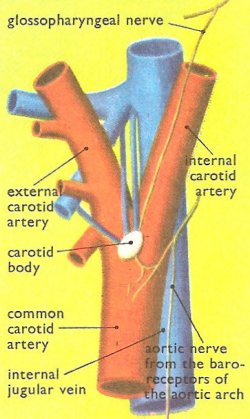carotid artery

The carotid and related arteries. Credit: Texas Heart Institute.
A carotid artery is any of the four main arteries that supplies blood to the head. A pair of common carotid arteries run up the neck, each branching into an external and an internal artery, which supply the head with oxygenated blood.
The left common carotid artery arises from the aorta just above the heart, and runs up the neck on the left side of the trachea. Just above the level of the larynx it divides into two, forming the left internal carotid and the left external carotid arteries. The right common carotid arises from the subclavian artery, which branches off the aorta, and then follows a similar path to the left common carotid, but on the other side of the neck.
The external carotid arteries have numerous branches, which supply most of the tissues in the face, scalp, mouth, and jaws. The internal carotid arteries enter the skull to supply the brain (via cerebral branches). At the base of the brain, branches of the two internal carotids and the basilar artery join to form a ring of blood vessels called the circle of Willis. Narrowing of these vessels may be associated with transient ischemic attack, while obstruction causes a stroke.
The carotid arteries have two specialized sensory regions in the neck, called the carotid sinus and the carotid body.
 |
| The site of the carotid sinus and the carotid body at the bifurcation of the common carotid artery. |
Carotid sinus
A carotid sinus is a pocket in the wall of a carotid artery, at its division in the neck, containing receptors that measure blood pressure (see baroreceptor). When blood pressure is raised, impulses travel from the receptors to the vasomotor center in the brain, which initiates a reflex vasodilation and slowing heart rate to lower the blood pressure to normal.
Carotid body
A carotid body is a small mass of tissue in a carotid sinus containing chemoreceptors that monitor levels of oxygen, carbon dioxide, and hydrogen ions in the blood. If the oxygen level falls, the chemoreceptors send impulses to the cardiac and respiratory centers in the brain, which promote increases in heart and respiration rates. It can give rise to carotid body tumors.



